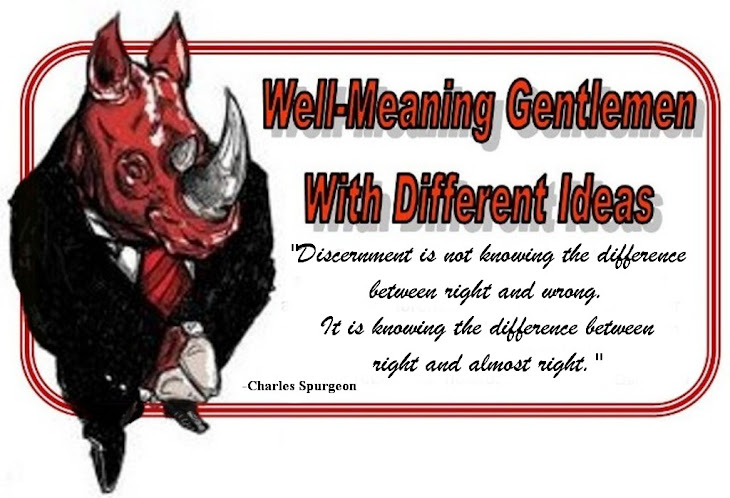Some of the biggest obstacles standing in the way of successful transformation from the old ways of simply preaching and teaching to a new market driven church model are "resisters." Change agents must view all dissenters as wrong. Anyone who disagrees is viewed as intolerable barriers to the Purpose. Change agents must be aware of them, identify them and curb their influence and effectiveness. 
Rick Warren endorses a popular church management tool titled, Leading Congregational Change, as “a book you ought to read before you change anything.” It sets a very negative tone in describing resistance. Resistance is defined as “the opposite reaction to change. It can come in many different forms – confrontational or passive-aggressive, from known troublemakers or loyal supporters…”
The book outlines the following steps for dealing with resistence:

Rick Warren endorses a popular church management tool titled, Leading Congregational Change, as “a book you ought to read before you change anything.” It sets a very negative tone in describing resistance. Resistance is defined as “the opposite reaction to change. It can come in many different forms – confrontational or passive-aggressive, from known troublemakers or loyal supporters…”
The book outlines the following steps for dealing with resistence:
- Identify Resisters. These are those who question the need for systemic change, distrust the dialectic process, and criticize the transformational methods. They refuse to shift their primary focus from the actual Scriptures to the positively phrased "purpose" or "vision" or "mission statement." LCC warns change leaders to expect resisters and identify them to the rest of the change team in order to lessen their impact. Rick Warren actually demonstrates his open hostility to resisters by comparing them to a disease that must be dispelled for the body to be healthy. In The Purpose Driven Church, he writes:
"When a human body is out of balance we call that disease.... Likewise, when the body of Christ becomes unbalanced, disease occurs.... Health will occur only when everything is brought back into balance. The task of church leadership is to discover and remove growth-restricting diseases and barriers so that natural, normal growth can occur."
Resisters may be identified in two ways; they may have spoken out previously or they may have come privately with objections. It is important to identify them before they become vocal and committed to obstruction.
2. Assess Resisters and Determine the Degree of Resistance. Leadership Network has a “feedback” data system available to help track negative or uncompromising attitudes of members. According to the Change Agent’s Guide, "Resisters should be judged for relative sophistication and influence." [
3. Befriend, Involve and Persuade Borderline Resisters. Participation in small group dialogues may encourage some borderline resisters to conform to the group’s peer pressure. Others will quietly leave on their own.
"Coercive power only strengthens resistance," wrote Robert Vanourek in Reflections on Leadership. "...Instead the leader's skills at 'facilitating' the group should be used. The ideas should evolve from the group. Then the leaders can simplify them in a persuasive fashion. Then commitment to the vision can be gained."
The most effective way to deal with resistance is to divert the attention off the truth and play on emotions with a lot of touchy-feely, compromising happycrap. "For unity's sake, we must never let differences divide us," wrote Pastor Warren. "We must stay focused on what matters most — learning to love each other as Christ has loved us, and fulfilling God's five purposes for each of us and his church."
4. Marginalize More Persistent Resisters. They obstruct progress and it may become necessary to encourage "divisive" members to go elsewhere. That is usually not too difficult because when those members leave, they usually keep quiet out of “obedience to the Lord” for the sake of avoiding strife and conflict. Of course, some will stay and fight. When that happens, The LCC outlines how change leaders should bastardize Scripture by misusing Matthew 18 out of context to deal with unruly members.
5. Vilify Those Who "Stay And Fight." In the book, Making Change Happen One Person at a Time: Assessing Change Capacity Within Your Organization, resisters were labeled "tares in a wheat field." At this stage, negative labels, accusations and slander are permitted, if not encouraged, to circulate. Resisters — now labeled as divisive troublemakers — are vilified and blamed for disunity, for slowing the change process, and for distracting the church body from wholehearted focus on its all-important vision, mission or purpose.
Ironically, those change agents who despise the doctrines of separation from worldliness and unbiblical alliances, employ the use of church discipline, isolation and excommunication of members who are faithful to the Word of God.
6. Establish Rules, Regulations, Laws and Principles That Silence, Punish or Drive Out Resisters. At Saddleback, every new member must sign a "Membership Covenant." It includes this innocuous promise: "I will protect the unity of my church... by following the leaders." This covenant is backed by more of the same kind of sloppy and irresponsible misapplications of verses such as Ephesians 4: 29 ("Do not let any unwholesome talk come out of your mouths....") and Hebrews 13:17 ("Obey your leaders and submit to their authority....") that keep scripturally ignorant members submissive and silent.


No comments:
Post a Comment